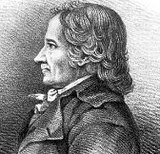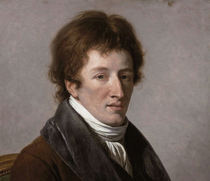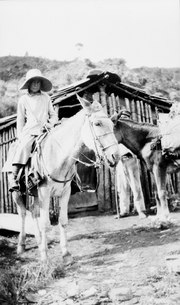Wiki Nature:Distinguished author
Distinguished authors
2015
December

Johan Christian Fabricius
(1745–1808)
A Danish zoologist, specialising in entomology. He was a student of Carolus Linnaeus in Uppsala (Sweden), and then appointed a professor at the University of Copenhagen (Denmark) as well as the University of Kiel (officially Germany, but ruled by the Danish king through a personal union). Fabricius is considered one of the most important entomologists of the 18th century, having named 9,776 species of animals, and established the basis for the modern insect classification. He added two distinct areas to the classification system: both artificial and natural characteristics. Artificial characteristics allowed for the determination of a species, and natural characteristics for the relationship to other genera and varieties. Much of his system still remains the basis of modern insect classification. Towards the end of his career Fabricius spent much of his time living in Paris, where he frequently met with naturalists such as Georges Cuvier and Pierre André Latreille.
See also: Distinguished authors of previous months.
2016
January

Franz Steindachner
(1834–1919)
An Austrian zoologist, ichthyologist, and herpetologist. Steindachner published over 200 papers on fishes and over 50 papers on reptiles and amphibians, and described hundreds of new species of fish and dozens of new amphibians and reptiles. At least seven species of reptile have been named after him.
Being interested in natural history, Steindachner took up the study of fossil fishes. In 1860 he was appointed to the position of director of the fish collection at the Naturhistorisches Museum in Vienna, a position which had remained vacant since the death of Johann Jakob Heckel in 1857. Steindachner's reputation as an ichthyologist grew, and in 1868 he was invited by Swiss-born American zoologist Louis Agassiz to accept a position at the Museum of Comparative Zoology at Harvard University. Steindachner took part in the USCSS Hassler Expedition of 1871–1872; a journey that circumnavigated South America from Boston to San Francisco. In 1874 he returned to Vienna, and in 1887 was appointed director of the zoological department of the Naturhistorisches Museum. He was promoted to director of the museum in 1898. He traveled extensively during his career, his research trips taking him throughout the Iberian Peninsula, the Red Sea, the Canary Islands, Senegal, Latin America, and more.
From 1875, he was member of the Vienna Academy of Sciences. In 1892 he became a member of the German Academy of Sciences Leopoldina.See also: Distinguished authors of previous months.
April
Adriana Hoffmann Jacoby
Born 1940. Standard IPNI form: A.E.Hoffm.
As a Chilean botanist and environmentalist, Adriana Hoffmann Jacoby has authored over a dozen books on the flora of Chile and has identified and classified more than 100 new species of cacti. She was Chile's Environment Minister in 2000 and 2001. She has advocated for the sustainable management and protection of Chilean forests, leading opposition to illegal logging in her role as coordinator of Defensores del Bosque Chileno (Defenders of the Chilean Forest) since 1992.
Hoffmann was recognized by the United Nations in 1997 as one of the 25 leading environmentalists of the decade for her efforts to protect Chile's forests. In 1999 she won the National Environmental Prize in the category of Environmental Education, awarded by Comisión Nacional del Medio Ambiente (CONAMA). For her research into Chilean flora and her work in environmental education, Hoffmann received the Luis Oyarzún Award from the Austral University of Chile in 2003. She received a Fellow Award from the Cactus and Succulent Society of America in 2009.
Hoffmann has also served on the judging panel for the United Nations Environment Programme's Sasakawa Prize.See also: Distinguished authors of previous months.
June

Charles Lucien Bonaparte
May 24, 1803 – July 29, 1857. Author abbreviation: Bonaparte
Charles Lucien ("Carlo Luciano") Bonaparte was French zoologist specialized in ornithology and ichthyology. He also studied amphibians and reptiles and is the author of Ursini's viper, Vipera ursinii. Bonaparte was the son of Lucien Bonaparte and Alexandrine de Bleschamp, and a nephew of Emperor Napoleon. Born in Paris, he was raised in Italy. After getting married to Zénaïde Bonaparte, he and his wife left for Philadelphia in the United States to live with Joseph Bonaparte, father of Zénaïde. Before leaving Italy, Charles had already discovered a warbler new to science, the moustached warbler (Acrocephalus melanopogon), and on the voyage he collected specimens of a new storm-petrel, Oceanites oceanicus. On arrival in the United States he presented a paper on this new bird, which was later named Wilson's storm petrel (after Alexander Wilson).
At the end of 1826, Bonaparte and his family returned to Europe. He visited Germany, where he met Philipp Jakob Cretzschmar, and England, where he met John Edward Gray at the British Museum, and renewed his acquaintance with John James Audubon. In 1828, the family settled in Rome. In Italy, he was the originator of several scientific congresses, and lectured and wrote extensively on American and European ornithology and other branches of natural history. Between 1832 and 1841, Bonaparte published his work on the animals of Italy, Iconografia della Fauna Italica. He had also published Specchio Comparativo delle Ornithologie di Roma e di Filadelfia (Pisa, 1827), presenting a comparison between birds of the latitude of Philadelphia and Italian species. He created the genus Zenaida, after his wife, for the mourning dove (Zenaida macroura) and its relatives. He was elected a member of the American Antiquarian Society in 1845.
In 1850, Bonaparte and his family of wife and twelve children moved to France, and he made Paris his home for the rest of his life. In 1854, he became director of the Jardin des Plantes. In 1855, he was made a foreign member of the Royal Swedish Academy of Sciences. He published the first volume of his Conspectus Generum Avium before his death, the second volume being edited by Hermann Schlegel. Lucien Charles Bonaparte died in Paris at the age of 54.
See also: List of 53 taxa authored by Charles Lucien Bonaparte ⁂ Distinguished authors of previous months
August

Mary Agnes Chase
1869–1963. Standard IPNI form: Chase
Mary Agnes Chase, née Merrill, was an American botanist who worked at the U.S. Department of Agriculture and the Smithsonian Institution. She is considered one of the world's outstanding agrostologists and is known for her work on the study of grasses, and also for her work as a suffragist. Chase was born in Iroquois County, Illinois and held no formal education beyond grammar school. That aside, she made significant contributions to the field of botany, authored over 70 scientific publications, and was conferred with an honorary doctorate in science from the University of Illinois. She specialized in the study of grasses and conducted extensive field work in North- as well as and South America. Her Smithsonian Field Books collection from 1897 to 1959 is archived in the Smithsonian Institution Archives.
In 1901, Chase became a botanical assistant at the Field Museum of Natural History under Charles Frederick Millspaugh, where her work was featured in two museum publications: Plantae Utowanae (1900) and Plantae Yucatanae (1904). Two years later, Chase joined the U.S. Department of Agriculture (USDA) as a botanical illustrator and eventually became a scientific assistant in systematic agrostology (1907), assistant botanist (1923), and associate botanist (1925), all under Albert Spear Hitchcock. Chase worked with Hitchcock for almost twenty years, collaborating closely and also publishing, for instance The North American Species of Panicum (1910).
Following Hitchcock's death in 1936, Chase succeeded him to become senior botanist in charge of systematic agrostology and custodian of the Section of Grasses, Division of Plants at the United States National Museum (USNM). Chase retired from the USDA in 1939, but continued her work as custodian of the USNM grass herbarium until her death in 1963. She was an Honorary Fellow of the Smithsonian Institution (1959) and Fellow of the Linnean Society of London (1961). Agnesia is named in her honour (a monotypic genus of herbaceous South American bamboo in the grass family).
Chase experienced discrimination based on her gender in the scientific field, for example, being excluded from expeditions to Panama in 1911 and 1912 because the expedition's benefactors feared the presence of women researchers would distract men. During World War I, Chase marched with Alice Paul and was jailed several times for her activities. In 1918, she was arrested at the Silent Sentinels rally picketing the White House; she refused bail and was held for 10 days, where she instigated a hunger-strike and was force-fed. The USDA accused her of "conduct unbecoming a government employee," but Hitchcock helped her keep her job. Chase was also an active member of the National Association for the Advancement of Colored People (NAACP).
See also: Distinguished authors of previous months.2017
May

Francesco Redi
1626–1697. Standard IPNI form: Redi
Francesco Redi was an Italian entomologist, parasitologist and toxicologist, sometimes referred to as the "founder of experimental biology" and the "father of modern parasitology". Having a doctoral degree and in both medicine and philosophy from the University of Pisa at the age of 21, he worked in various cities of Italy.
Redi is best known for his series of experiments, published in 1668 as Esperienze Intorno alla Generazione degli Insetti ("Experiments on the Generation of Insects"), which is regarded as his masterpiece and a milestone in the history of modern science. The book is one of the first steps in refuting "spontaneous generation", a theory also known as "Aristotelian abiogenesis". At the time, prevailing theory was that maggots arose spontaneously from rotting meat, which Redi was able to disprove. In an experiment, He used samples of rotting meat that were either fully exposed to the air, partially exposed to the air, or not exposed to air at all. Redi showed that both fully and partially exposed rotting meat developed fly maggots, whereas rotting meat that was not exposed to air did not develop maggots. This discovery completely changed the way people viewed the decomposition of organisms and prompted further investigations into insect life cycles and into entomology in general. It is also an early example of forensic entomology.
In Esperienze Intorno alla Generazione degli Insetti Redi was the first to describe ectoparasites, such as lice (Phthiraptera), fleas (Siphonaptera), and some mites (Acari). His next treatise in 1684, titled Osservazioni intorno agli animali viventi che si trovano negli animali viventi ("Observations on Living Animals, that are in Living Animals") recorded the descriptions and the illustrations of more than 100 parasites. In it he also differentiates the earthworm (generally regarded as a helminth) and Ascaris lumbricoides, the human roundworm. An important innovation from the book is his experiments in chemotherapy in which he employed what is now called "scientific control", the basis of experimental design in modern biological research. Perhaps, his most significant observation was that parasites produce eggs and develop from them, which contradicted the prevailing opinion that they are produced spontaneously. Altogether he is known to have described some 180 species of parasites.
See also: Distinguished authors of previous months.2018
July

Georges Cuvier
1769–1832. Standard IPNI form: Cuvier
Georges Léopold Chrétien Frédéric Dagobert Cuvier (most often published simply as "Georges Cuvier") was a French naturalist and zoologist. He is sometimes referred to as the founding father of paleontology. Cuvier was a major figure in natural sciences research in the early 19th century and was instrumental in establishing the fields of comparative anatomy and paleontology through his work in comparing living animals with fossils. Cuvier's work is considered the foundation of vertebrate paleontology, and he expanded Linnaean taxonomy by grouping classes into phyla and incorporating both fossils and living species into the classification. Cuvier is also known for establishing extinction as a fact: at the time, extinction was considered by many of Cuvier's contemporaries to be merely controversial speculation.
He is also remembered for strongly opposing theories of evolution, which at the time (before Darwin's theory) were mainly proposed by Jean-Baptiste Lamarck and Étienne Geoffroy Saint-Hilaire. Cuvier believed there was no evidence for evolution, but rather evidence for cyclical creations and destructions of life forms by global extinction events such as deluges (outburst flooding).
Cuvier wrote hundreds of scientific papers and books. His most famous work is Le Règne Animal (1816–1817, four tomes; English title The Animal Kingdom). It sets out to describe the natural structure of the whole of the animal kingdom based on comparative anatomy, and its natural history. Cuvier divided the animals into four embranchements ("Branches", roughly corresponding to phyla), namely vertebrates, molluscs, articulated animals (arthropods and annelids), and zoophytes (cnidaria and other phyla).
He is the author of thousands of new taxa, among them well over 5,000 species of fish and molluscs. In 1800 and working only from a drawing, Cuvier was the first to correctly identify in print, a fossil found in Bavaria as a small flying reptile, which he named the Ptero-Dactyle in 1809 (later Latinized as Pterodactylus antiquus).
When the French Academy was preparing its first dictionary, it defined "crab" as "A small red fish which walks backwards." This definition was sent with a number of others to the naturalist Cuvier for his approval. The scientist wrote back: "Your definition, gentlemen, would be perfect, only for three exceptions. The crab is not a fish, it is not red, and it does not walk backwards." In 1819, he was created a peer for life in honour of his scientific contributions and is thereafter known as Baron Cuvier.
See also: Distinguished authors of previous months.2019
August

Mary Agnes Chase
1869–1963. Standard IPNI form: Chase
Mary Agnes Chase, née Merrill, was an American botanist who worked at the U.S. Department of Agriculture and the Smithsonian Institution. She is considered one of the world's outstanding agrostologists and is known for her work on the study of grasses, and also for her work as a suffragist. Chase was born in Iroquois County, Illinois and held no formal education beyond grammar school. That aside, she made significant contributions to the field of botany, authored over 70 scientific publications, and was conferred with an honorary doctorate in science from the University of Illinois. She specialized in the study of grasses and conducted extensive field work in North- as well as and South America. Her Smithsonian Field Books collection from 1897 to 1959 is archived in the Smithsonian Institution Archives.
In 1901, Chase became a botanical assistant at the Field Museum of Natural History under Charles Frederick Millspaugh, where her work was featured in two museum publications: Plantae Utowanae (1900) and Plantae Yucatanae (1904). Two years later, Chase joined the U.S. Department of Agriculture (USDA) as a botanical illustrator and eventually became a scientific assistant in systematic agrostology (1907), assistant botanist (1923), and associate botanist (1925), all under Albert Spear Hitchcock. Chase worked with Hitchcock for almost twenty years, collaborating closely and also publishing, for instance The North American Species of Panicum (1910).
Following Hitchcock's death in 1936, Chase succeeded him to become senior botanist in charge of systematic agrostology and custodian of the Section of Grasses, Division of Plants at the United States National Museum (USNM). Chase retired from the USDA in 1939, but continued her work as custodian of the USNM grass herbarium until her death in 1963. She was an Honorary Fellow of the Smithsonian Institution (1959) and Fellow of the Linnean Society of London (1961). Agnesia is named in her honour (a monotypic genus of herbaceous South American bamboo in the grass family).
Chase experienced discrimination based on her gender in the scientific field, for example, being excluded from expeditions to Panama in 1911 and 1912 because the expedition's benefactors feared the presence of women researchers would distract men. During World War I, Chase marched with Alice Paul and was jailed several times for her activities. In 1918, she was arrested at the Silent Sentinels rally picketing the White House; she refused bail and was held for 10 days, where she instigated a hunger-strike and was force-fed. The USDA accused her of "conduct unbecoming a government employee," but Hitchcock helped her keep her job. Chase was also an active member of the National Association for the Advancement of Colored People (NAACP).
See also: Distinguished authors of previous months.